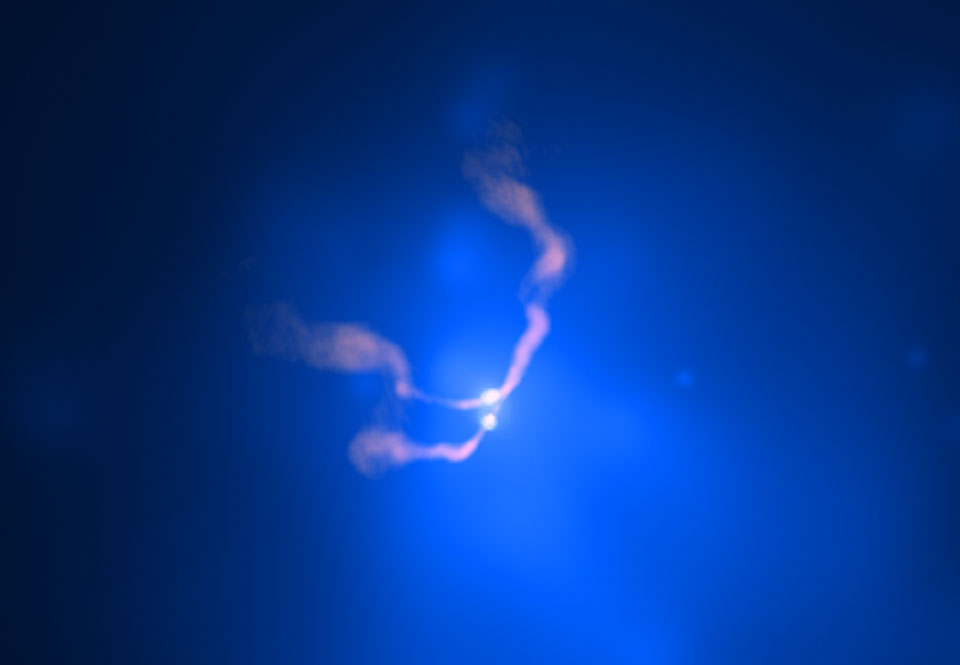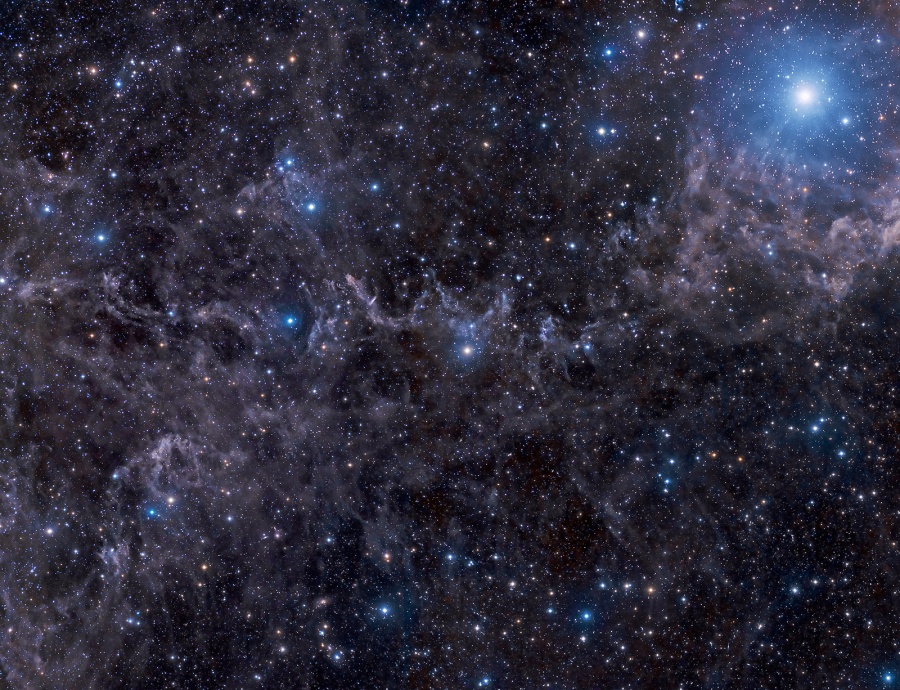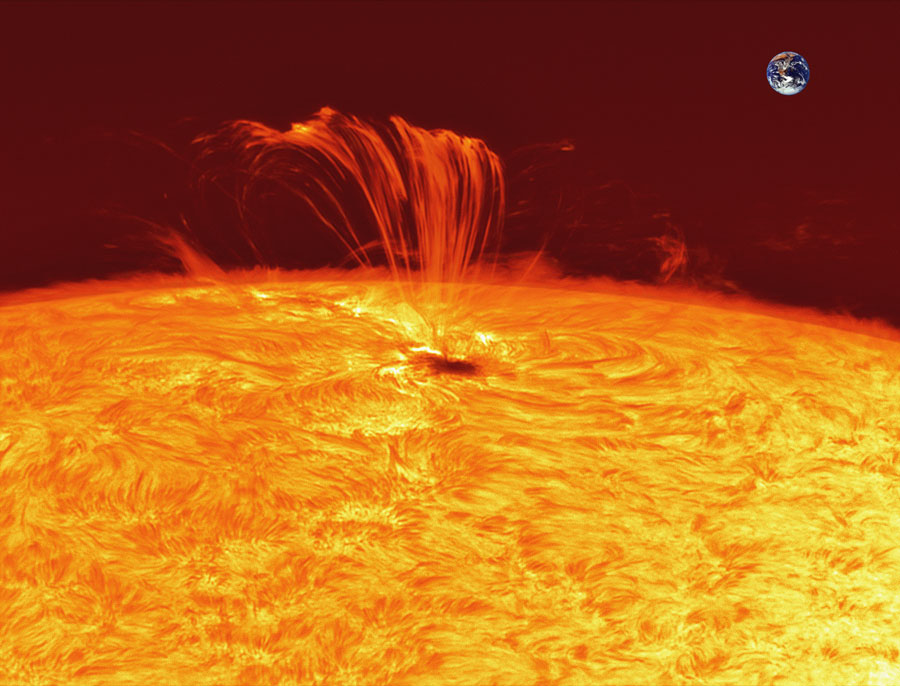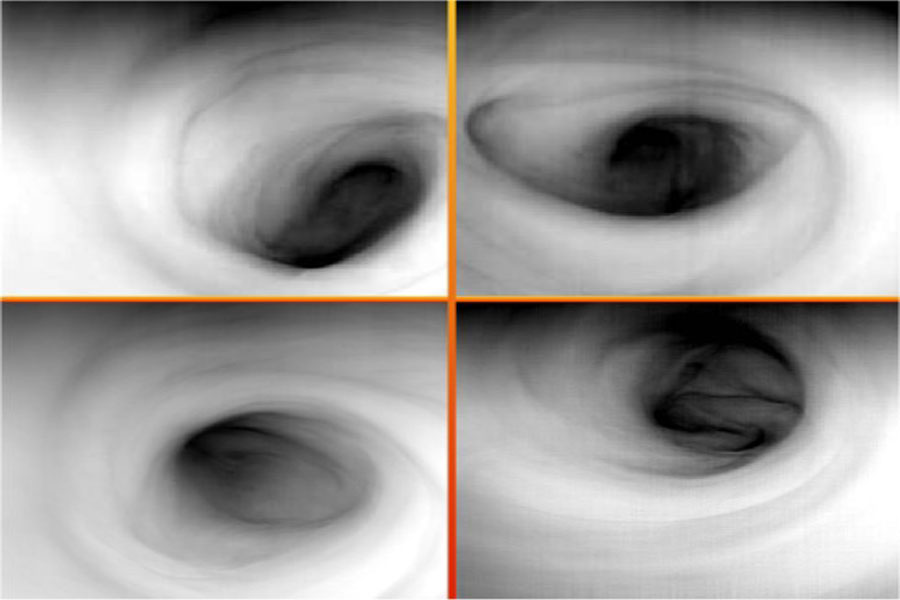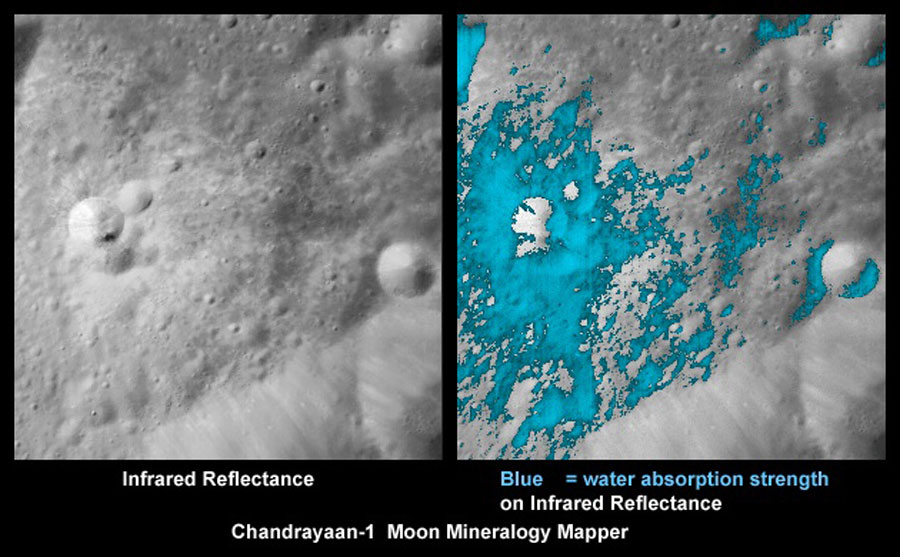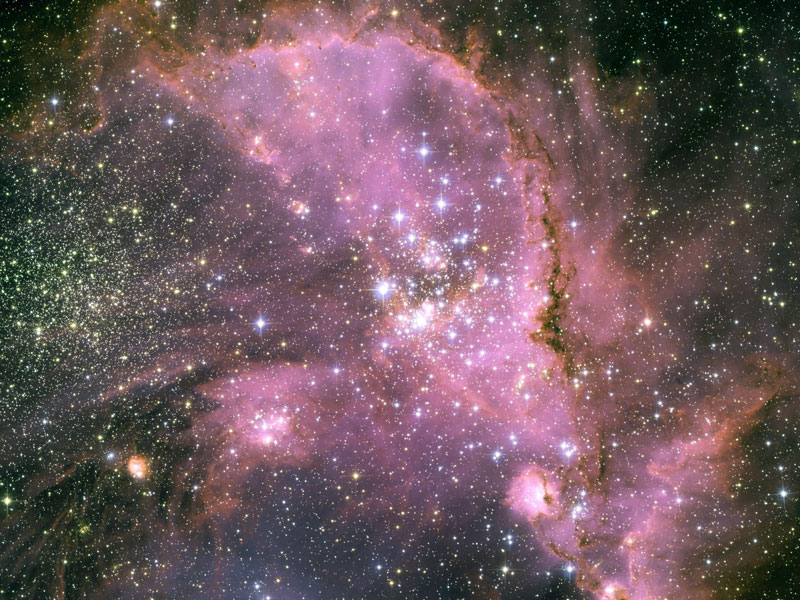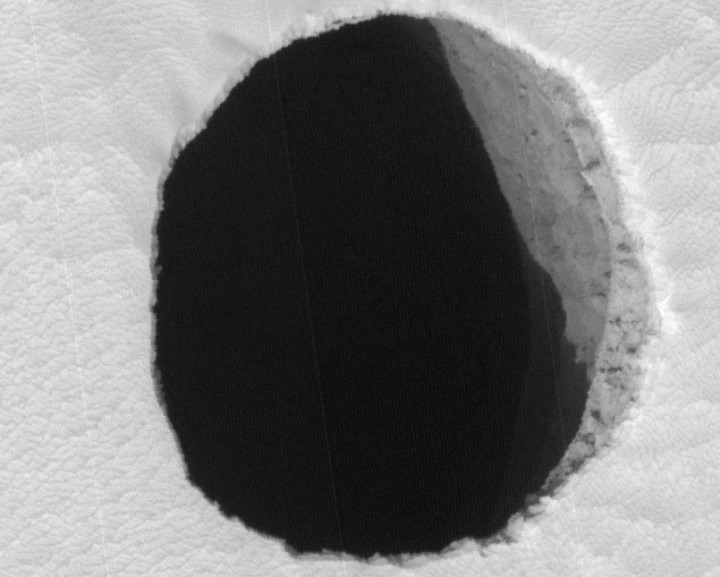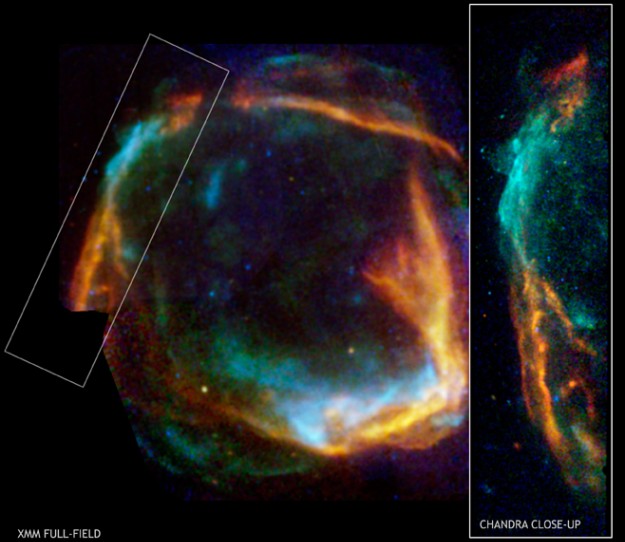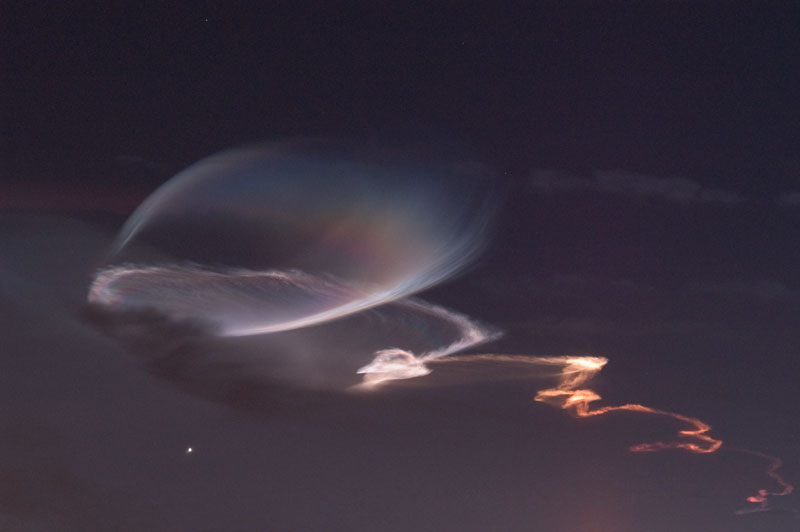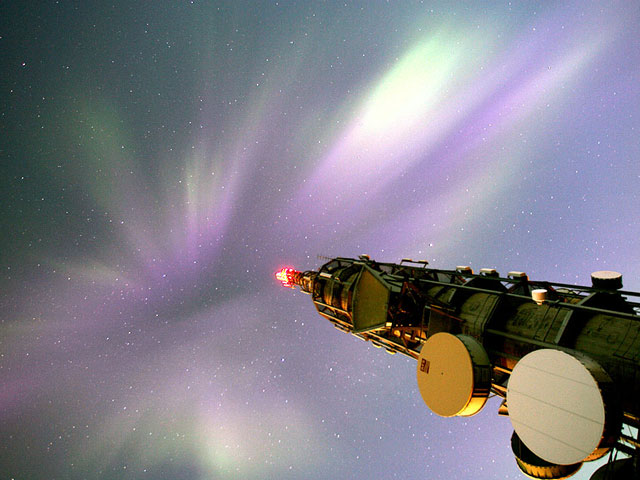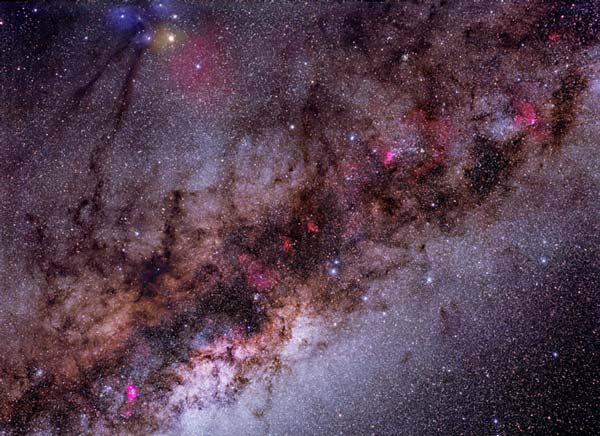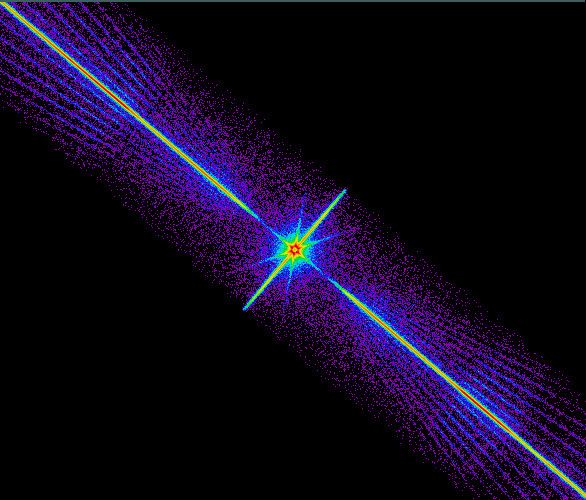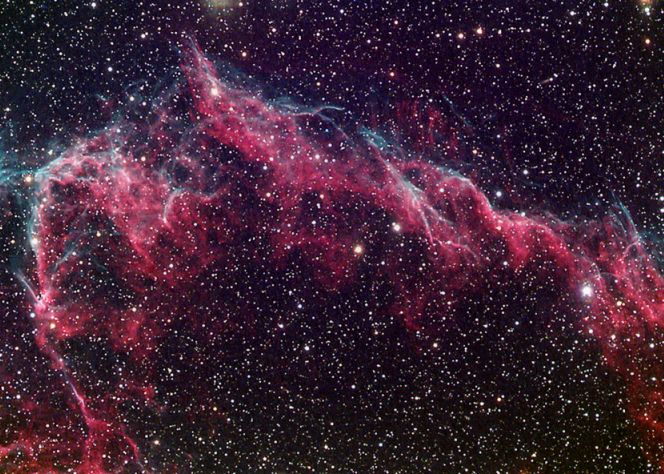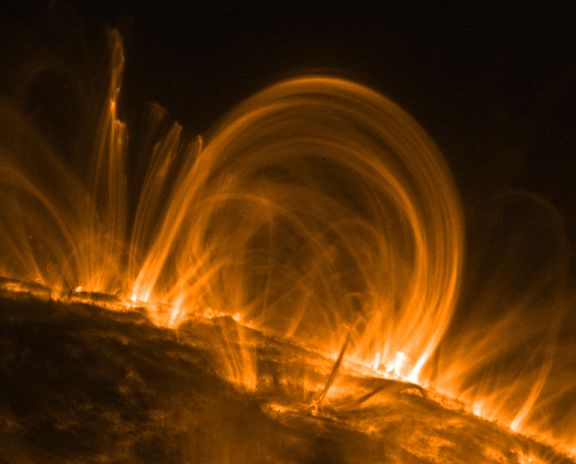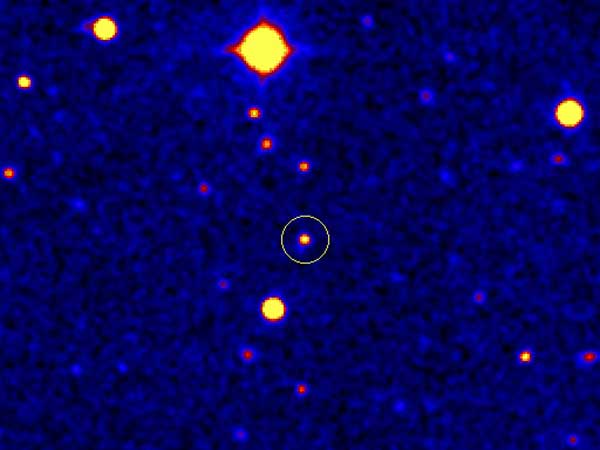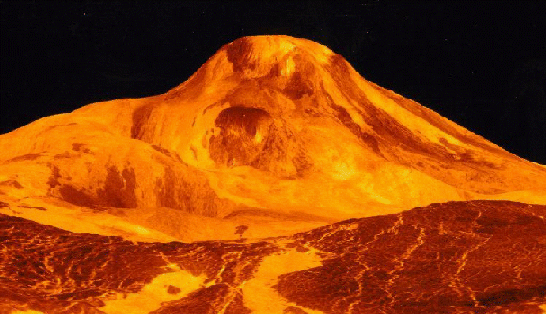2014 What's happening at the center of active galaxy 3C 75? The two bright sources at the center of this composite x-ray (blue)/ radio (pink) image are co-orbiting supermassive black holes powering the giant radio source 3C 75. Surrounded by multimillion degree x-ray emitting gas, and blasting out jets of relativistic particles the supermassive black holes are separated by 25,000 light-years. At the cores of two merging galaxies in the Abell 400 galaxy cluster they are some 300 million light-years away. Astronomers conclude that these two supermassive black holes are bound together by gravity in a binary system in part because the jets' consistent swept back appearance is most likely due to their common motion as they speed through the hot cluster gas at 1200 kilometers per second. Such spectacular cosmic mergers are thought to be common in crowded galaxy cluster environments in the distant universe. In their final stages the mergers are expected to be intense sources of gravitational waves.
2013
2012 Bright star Markab anchors this dusty skyscape. At the top right corner of the frame, Markab itself marks a corner of an asterism known as the Great Square, found within the boundaries of the constellation Pegasus, the flying horse. The wide and deep telescopic view rides along for some 5 degrees or about 10 times the angular diameter of the Full Moon, with blue reflection nebulae scattered around the scene. And even though this line-of-sight looks away from the plane of our Milky Way galaxy, it covers a region known to be filled with nearby molecular clouds. The associated dust clouds, high latitude galactic cirrus, are less than 1,000 light-years distant. Still apparent, but far beyond the Milky Way, are background galaxies, like the prominent edge-on spiral NGC 7497 near picture center.
2011 One of the most active sunspot groups in years is currently crossing the Sun. AR 1302 first came around the Sun's edge last week and is so large it can be seen without a telescope. Coronal Mass Ejections from AR 1302 have already caused strong geomagnetic storms including notable aurora activity around both of Earth's poles. Pictured above, plasma was left magnetically hanging above the Sun's surface after AR 1302 emitted an X-class solar flare last Thursday. Earth is illustrated in the inset for a size comparison. Although another X-class flare was emitted on Saturday, no flares from AR 1302 have been aimed directly at the Earth, as yet. The AR 1302 sunspot group will continue to evolve but likely remain visible on the Sun for the next week.
2010 What's happening over the South Pole of Venus? To find out, scientists have been studying images taken by the robotic Venus Express spacecraft when it passes over the lower spin axis of Earth's overheated twin. Surprisingly, recent images from Venus Express do not confirm previous sightings of a double storm system there, but rather found a single unusual swirling cloud vortex. In the above recently released image sequence taken in infrared light and digitally compressed, darker areas correspond to higher temperatures and hence lower regions of Venus' atmosphere. Also illuminating are recently released movies, which show similarities between Venus' southern vortex and the vortex that swirls over the South Pole of Saturn. Understanding the peculiar dynamics of why, at times, two eddies appear, while at other times a single peculiar eddy appears, may give insight into how hurricanes evolve on Earth, and remain a topic of research for some time. In three months, the European Venus Express spacecraft will be joined around Venus by the Japanese Akatsuki satellite.
2009 Water has been discovered on the surface of the Moon. No lakes have been found, but rather NASA's Moon Mineralogy Mapper aboard India's new Chandrayaan-1 lunar orbiter radios back that parts of the Moon's surface absorb a very specific color of light identified previously only with water. Currently, scientists are trying to fit this with other facts about the Moon to figure out how much water is there, and even what form this water takes. Unfortunately, even the dampest scenarios leave our moon dryer than the driest of Earth's deserts. A fascinating clue being debated is whether the water signal rises and falls during a single lunar day. If true, the signal might be explainable by hydrogen flowing out from the Sun and interacting with oxygen in the lunar soil. This could leave an extremely thin monolayer of water, perhaps only a few molecules thick. Some of the resulting water might subsequently evaporate away in bright sunlight. Pictured above, the area near a crater on the far side of the Moon shows a relatively high abundance of water-carrying minerals in false-color blue. Next week, the new LCROSS satellite will release an impactor that will strike a permanently shadowed crater near the lunar south pole to see if any hidden water or ice sprays free there.
2008 The massive stars of NGC 346 are short lived, but very energetic. The star cluster is embedded in the largest star forming region in the Small Magellanic Cloud, some 210,000 light-years distant. Their winds and radiation sweep out an interstellar cavern in the gas and dust cloud about 200 light-years across, triggering star formation and sculpting the region's dense inner edge. Cataloged as N66, the star forming region also appears to contain a large population of infant stars. A mere 3 to 5 million years old and not yet burning hydrogen in their cores,the infant stars are strewn about the embedded star cluster. In the above false-color Hubble Space Telescope image, visible and near-infrared light are seen as blue and green, while light from atomic hydrogen emission is red.
2007 In a close-up from the HiRISE instrument onboard the Mars Reconnaissance Orbiter, this mysterious dark pit, about 150 meters across, lies on the north slope of ancient martian volcano Arsia Mons. Lacking raised rims and other impact crater characteristics, this pit and others like it were originally identified in visible light and infrared images from the Mars Odyssey and Mars Global Surveyor spacecraft. While the visible light images showed only darkness within, infrared thermal signatures indicated that the openings penetrated deep under the martian surface and perhaps were skylights to underground caverns. In this later image, the pit wall is partially illuminated by sunlight and seen to be nearly vertical, though the bottom, at least 78 meters below, is still not visible. The dark martian pits are thought to be related to collapse pits in the lava flow, similar to Hawaiian volcano pit craters.
2006 In 185 AD, Chinese astronomers recorded the appearance of a new star in the Nanmen asterism - a part of the sky identified with Alpha and Beta Centauri on modern star charts. The new star was visible for months and is thought to be the earliest recorded supernova. Data from two orbiting X-ray telescopes of the 21st century, XMM-Newton and Chandra, now offer evidence that supernova remnant RCW 86 is indeed the debris from that stellar explosion. Their composite, false-color view of RCW 86 shows the expanding shell of material glowing in x-rays with high, medium, and low energies shown in blue, green, and red hues. Shock velocities measured in the x-ray emitting shell and an estimated radius of about 50 light-years can be used to find the apparent age of the remnant. The results indicate that light from the initial explosion could well have first reached planet Earth in 185 AD. Near the plane of our Milky Way Galaxy, RCW 86 is about 8,200 light-years away.
2005 What kind of cloud is that? Last week, a sunset rocket launch lit up the sky and was photographed by sky enthusiasts as far as hundreds of miles away. The lingering result was a photogenic rocket plume. Not everyone who saw the resulting plume knew its cause to be a Minotaur rocket launched from Vandenberg Air Force Base in California, USA. The cloud was visible after sunset on 22 September. Fuel particles and water droplets expelled from the rocket swirled in the winds of the upper atmosphere, creating an expanding helix. The noctilucent plume was so high that it still reflected sunlight, where lower clouds in the foreground appeared dark. The above image also captured part of the plume reflecting sunlight as a rainbow or a colorful iridescent cloud. Below the launch plume is the planet Venus.
2004 Higher than highest communications tower, higher than highest mountain, higher than highest airplane, lies the realm of the aurora. Auroras rarely reach below 60 kilometers, and can range up to 1000 kilometers. Aurora light results from energetic electrons and protons striking molecules in the Earth's atmosphere. Frequently, when viewed from space, a complete aurora will appear as a circle around one of the Earth's magnetic poles. Pictured above is a particularly rare purple auroral corona that occurred on August 30, high above Harstad, Norway.
2003 The disk of our Milky Way Galaxy is home to hot nebulae, cold dust, and billions of stars. The red nebulae visible in the above contrast-enhanced picture are primarily emission nebulae, glowing clouds of hydrogen gas heated by nearby, bright, young stars. The blue nebulae are primarily reflection nebulae, clouds of gas and fine dust reflecting the light of nearby bright stars. Perhaps the most striking, though, are the areas of darkness, including the Pipe Nebula visible on the image top left. These are lanes of thick dust, many times containing relatively cold molecular clouds of gas. Dust is so plentiful that it obscures the Galactic Center in visible light, hiding its true direction until discovered early last century. The diffuse glow comes from billions of older, fainter stars like our Sun, which are typically much older than any of the nebulae. Most of the mass of our Galaxy remains in a form currently unknown.
2002 A drop of water or prism of glass can spread out visible sunlight into a rainbow of colors. In order of increasing energy, the well known spectrum of colors in a rainbow runs red, orange, yellow, green, blue, indigo, violet. X-ray light too can be spread out into a spectrum ordered by energy ... but not by drops of water or glass. Instead, the orbiting Chandra X-ray Observatory uses a set of 540 finely ruled, gold gratings to spread out the x-rays, recording the results with digital detectors. The resulting x-ray spectrum reveals much about the compositions, temperatures, and motions within cosmic x-ray sources. This false color Chandra image shows the x-ray spectrum of a star system in Ursa Major cataloged as XTE J1118+480 and thought to consist of a sun-like star orbiting a black hole. Unlike the familiar appearance of a prism's visible light rainbow, the energies here are ordered along radial lines with the highest energy x-rays near the center and lowest energies near the upper left and lower right edges of the image. The central spiky region itself is created by x-rays from the source which are not spread out by the array of gratings.
2001 After 5,000 years, the gorgeous Veil Nebula is still turning heads. Cataloged as NGC 6992, these glowing filaments of interstellar shocked gas are part of a larger spherical supernova remnant known as the Cygnus Loop or the Veil Nebula -- expanding debris from a star which exploded over 5,000 years ago. This color digital image of a bit of the Veil has been processed and enhanced to reveal stunning details in the diaphanous cosmic cloud. Seen from our perspective against a rich Milky Way star field, the Veil Nebula is now known to lie some 1,400 light-years away toward the constellation Cygnus. At that distance, witnesses to the original stellar explosion would have seen a star in the heavens increase in brightness to about -8 magnitude, roughly corresponding to the brightness of the crescent Moon.
2000 Extending above the photosphere or visible surface of the Sun, the faint, tenuous solar corona can't be easily seen from Earth, but it is measured to be hundreds of times hotter than the photosphere itself. What makes the solar corona so hot? Astronomers have long sought the source of the corona's heat in magnetic fields which loft monstrous loops of solar plasma above the photosphere. Still, new and dramatically detailed observations of coronal loops from the orbiting TRACE satellite are now pointing more closely to the unidentified energy source. Recorded in extreme ultraviolet light, this and other TRACE images indicate that most of the heating occurs low in the corona, near the bases of the loops as they emerge from and return to the solar surface. The new results confound the conventional theory which relies on heating the loops uniformly. This tantalizing TRACE image shows clusters of the majestic, hot coronal loops which span 30 or more times the diameter of planet Earth.
1999 Explorers often discover the unexpected. Such was the case when the Second Palomar Observatory Sky Survey chanced upon the unusual object circled in the above photograph. The so-called mystery object appeared star-like but displayed colors unlike most stars or quasars. Further investigation has now revealed the object to be a Broad Absorption Line (BAL) quasar, a relatively rare type of active center of a distant galaxy. Different atoms and molecules in the absorbing gas surrounding the BAL quasar's center probably cause the unusual colors. We are fortunate enough to live in the fascinating age when much of the universe is being investigated for the first time, so exciting - and often unexpected - discoveries are sure to continue.
1998 Last Friday, Hurricane Georges was photographed from space entering the Gulf of Mexico. This immense storm system, larger than most states, is expected to make landfall today. Starting as a slight pressure difference, hurricanes grow into large spiraling storm systems of low pressure, complete with high winds and driving rain. A hurricane is powered by evaporating ocean water, and so typically gains strength over warm water and loses strength over land. Currently offshore in the Atlantic Ocean, Hurricanes Ivan, Jeanne, and Karl swirl, but will likely stay well away from North America.
1997
1996 Pictured above is a three person Russian Soyuz capsule with wing-like solar panels extended, joined to the Mir space station. In Russian soyuz means "union" and indeed one of the milestones achieved by a Soyuz spacecraft was an orbital union with a US Apollo command module during the first international space mission (Apollo-Soyuz) in 1975. The Soyuz TM spacecraft are specially modified for use with the Mir as ferries for cosmonauts and astronauts and also as lifeboats, should the need arise. This image is from an electronic still camera used by the crew of the Space Shuttle Atlantis during their latest Mir visit to pick up astronaut Shannon Lucid and drop off John Blaha.
1995 This computer generated view of a Venusian volcano was created using data from NASA's Magellan spacecraft. Magellan used its onboard radar to map the surface of Venus which is hidden from telescopic observations by a perpetual cloud cover. Using this radar data to provide three dimensional information, a computer was then able to produce this view of Maat Mons, a 5 mile high volcano, from a dramatic perspective. The colors used to render the surface are based on earlier color images transmitted by TV cameras on the Soviet Venera 13 and 14 Venus landers.
| << Previous | Index | Next >> |
